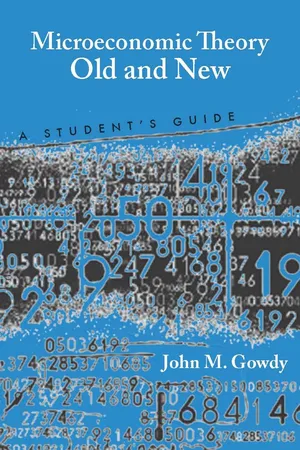INTRODUCTION AND OVERVIEW
The umbrella covering the various pieces of economic theory is called welfare economics. It provides the basic framework for applying the tools of economics to problems such as estimating the benefits of trade, valuing environmental features, and determining the criteria for sustainability. Far from being an esoteric footnote to economic theory, welfare economics provides the basic worldview of economists, giving answers to fundamental questions regarding the ultimate purpose of economic activity and the best policies to promote human well-being. The validity of some of the most widely used tools of economics—cost-benefit analysis, measures of total factor productivity, and Pareto efficiency—depends critically on the validity of the underlying welfare economic model.
For more than half a century, economic theory and policy has been dominated by a type of welfare economics called Walrasian economics, named after the political economist Léon Walras (1834–1910). The cornerstone of the Walrasian system is the characterization of human behavior embodied in “economic man,” or Homo economicus, whose preferences are assumed to be stable, consistent, and independent of the preferences of others. With this starting point, the leading figures in the “marginalist revolution” of the 1870s—William Stanley Jevons, Vilfredo Pareto, and Walras—constructed a mathematical model of an economy in equilibrium that defined the science of economics as “the optimal allocation of scarce resources among alternative ends.” In the decades following World War II this model not only came to dominate microeconomic analysis but also became the starting point for macroeconomics—the so-called microfoundations approach.
The starting point of the Walrasian system is the exchange of a fixed collection of goods among individuals bargaining directly with one another. The end result of free and voluntary exchange is that no further trading will make one person better off without making someone else worse off. This result is called Pareto efficiency, and it establishes one of the key ideas in modern economics, namely, the welfare benefits of trade. The next step is to introduce prices into the basic model and show that a perfectly operating market economy will duplicate the results of face-to-face bartering. The last part of the puzzle is to recognize that prices may be “imperfect” but that it is possible for enlightened intervention to correct these market failures and reestablish the conditions for Pareto efficiency.
THE THREE BUILDING BLOCKS OF THE WALRASIAN SYSTEM
The first building block of the Walrasian system is to establish that the free exchange of commodities will lead to Pareto efficiency in a pure barter economy. Individuals with a predetermined amount of commodities are allowed to directly and freely trade valuable goods with each other, and Pareto efficiency is achieved when no further trading can increase the well-being of one person without decreasing the well-being of another. The second building block is the demonstration that if market prices correctly reflect individual preferences, then a perfectly competitive market economy will lead to Pareto efficiency (the First Fundamental Theorem of Welfare Economics). That is, competition in free markets will exactly duplicate the Pareto efficient outcome that would result from direct negotiations and exchange in a barter economy. The third and final piece of the system is the recognition that the prices of market goods may be distorted for a variety of reasons. These price distortions, called market failures, include the broad categories of externalities, market power, and public goods. In these cases, governments have a legitimate role to play in correcting the failures of markets in order to establish the proper value (price) of things such as environmental services (the Second Fundamental Theorem of Welfare Economics). The underlying assumption is that people rationally and consistently respond to price signals.
To summarize the Walrasian system:
- Trading in a barter economy—Unfettered bartering by agents with stable preferences will lead to Pareto efficiency, a situation in which no further trading can make one person better off without making another person worse off.
- Adding prices—If prices correctly reflect consumer preferences, then competitive markets are always Pareto efficient. Free markets will exactly duplicate the results of a direct barter system.
- Adjusting prices—When market failures are present, enlightened government intervention can adjust market prices so that a socially efficient Pareto outcome can be established.
These three building blocks provide the worldview of most economists. The ultimate source of value and the ultimate arbiter of efficiency in the Walrasian system are the preferences of Homo economicus, whatever these preferences might be and however they are formed. These building blocks hold together only if all the assumptions defining Homo economicus and perfect competition are met.
Today, welfare economics is undergoing a revolution that promises to fundamentally change the way economists see the world. Walrasian welfare economics is being challenged by a new economics, grounded in behavioral science, that recognizes the social and biological context of decision making and the complexity of human behavior. The current sea change in economic theory offers a unique opportunity for economists, working together with other behavioral scientists, to move mainstream economic theories and policies toward an empirical, science-based approach unbounded by a priori assumptions.
This book has two goals. The first is to present clearly and precisely how the internal logic of the Walrasian model works. What is the starting point for the model, how do the pieces fit together, and what are the policy implications? The second is to present the current revolution in welfare economics and the theoretical and empirical challenges to Walrasian theory.
FURTHER READING
An essential source for background on economics concepts, definitions, and the history of economic thought is The New Palgrave Dictionary of Economics , 4 vols., ed. J. Eatwell, M. Milgate, and P. Newman (London and New York: Macmillan, 1987).
R...

